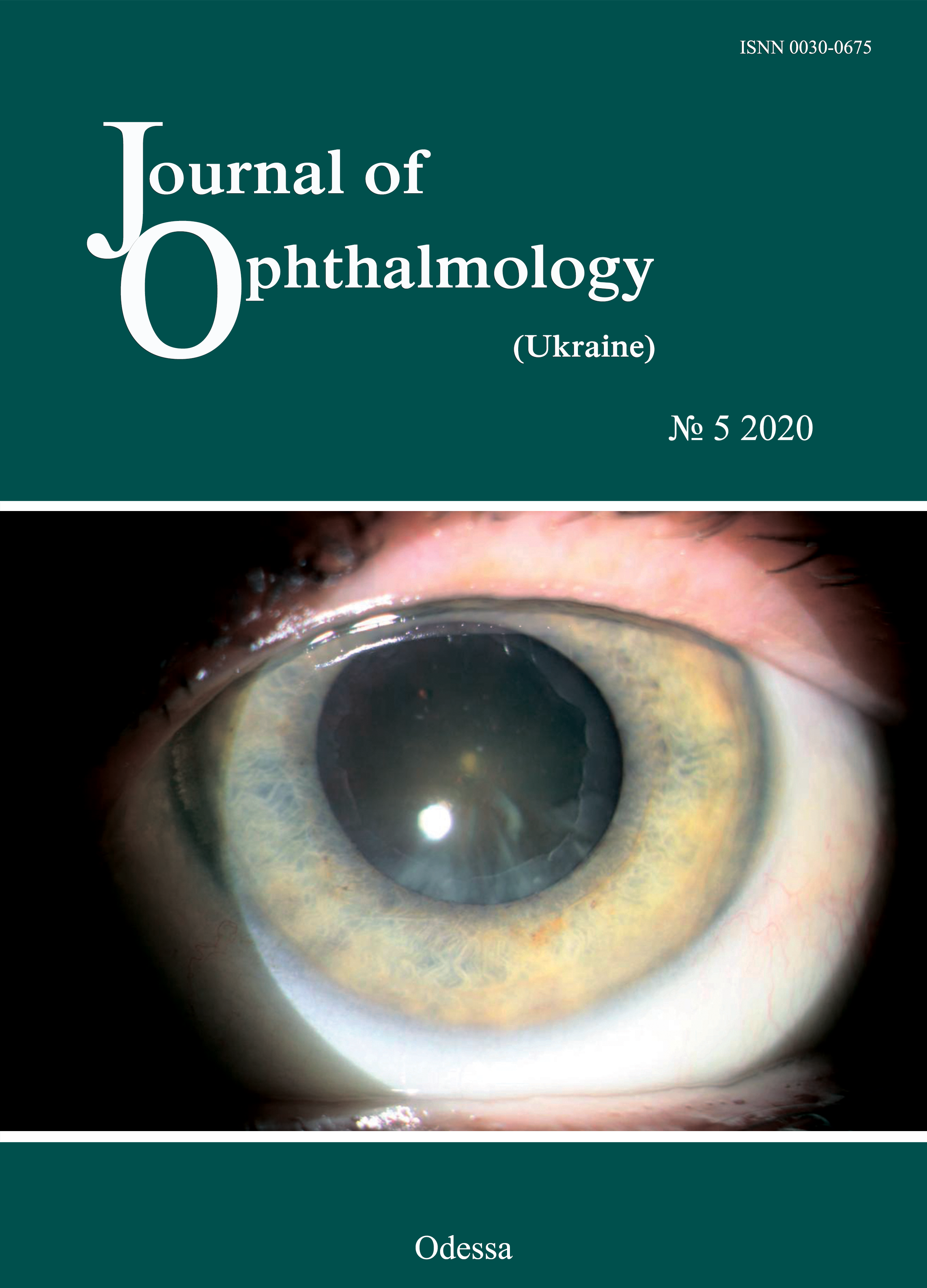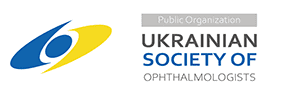OCT-measured morphological and structural parameters of the retinal ganglion cell complex in compressive optic neuropathy
DOI:
https://doi.org/10.31288/oftalmolzh202055155Keywords:
skull-base tumors, chiasmal syndrome, compressive optic neuropathy, optical coherence tomographyAbstract
Background: Skull-base tumors (SBTs) of the middle and anterior fossae cause compressive optic neuropathy which is accompanied by decreased visual acuity, bitemporal visual field defects and development of primary descending optic atrophy (OA). Optical coherence tomography (OCT) is an up-to-date non-invasive imaging modality that allows objective assessment of stereometric parameters of the optic nerve. Reduced peripapillary retinal nerve fiber layer thickness, reduced neuroretinal rim area, and reduced macular ganglion cell complex (GCC) thickness are characteristic changes in retinal morphology in compressive optic neuropathy.
Purpose: To analyze the changes in OCT-measured morphological and structural parameters of the retinal GCC in patients with primary optic atrophy due to compression by SBTs.
Material and Methods: This study included 57 patients (114 eyes) who received treatment for SBT and loss of visual acuity and/or visual fields at the Romodanov Neurosurgery Institute during 2017 through 2019. Patients underwent clinical and neurological, eye, otoneurological, neiroimaging and laboratory examination.
Results: There was a significant difference in average GCC thickness among any subgroup (Subgroup 1, 101.69 ± 4.01 nm; Subgroup 2, 98.6 ± 2.28 nm; Subgroup 3, 90.4 ± 3.92 nm; Subgroup 4, 80.8 ± 3.72 nm; Subgroup 5, 71.86 ± 5.31 nm) and controls (113.01±3.86 nm) (p < 0.05). Although no abnormalities in visual function were found in eyes of Subgroup 1 (no chiasmal syndrome before and after treatment), these eyes exhibited GCC thinning in superior nasal and inferior nasal segments (99.24±3.21 nm and 96.21±3.18 nm, respectively), which is an early sign of compressive optic neuropathy.
Conclusion: Binasal thinning of the GCC (a subclinical sign of chiasmal compression) reflects early mild damage to axons, precedes visual field defects and optic atrophy, and is an early indication for SBT removal.
References
1.Abouaf L, Vighetto A, Lebas M. Neuro-ophthalmologic exploration in non-functioning pituitary adenoma. Ann Endocrinol (Paris). 2015 Jul;76(3):210-9. https://doi.org/10.1016/j.ando.2015.04.006
2.Predoi D, Badiu C, Alexandrescu D, Agarbiceanu C, Stangu C, Ogrezeanu I, et al. Assessment of compressive optic neuropathy in long standing pituitary macroadenomas. Acta Endocrinologica (Buc). 2008 Jan; 4(1):11-22.https://doi.org/10.4183/aeb.2008.11
3.Ekpene U, Ametefe M, Akoto H et al. Pattern of intracranial tumours in a tertiary hospital in Ghana. Ghana Med J. 2018 Jun;52(2):79-83.https://doi.org/10.4314/gmj.v52i2.3
4.Masaya-anon P, Lorpattanakasem J. Intracranial tumors affecting visual system: 5-year review in Prasat Neurological Institute. J Med Assoc Thai. 2008; 91(4):515-19.
5.Kitthaweesin K, Ployprasith C. Ocular manifestations of suprasellar tumors. J Med Assoc Thai. 2008; 91(5):711-5.
6.Tagoe NN, Essuman VA., Fordjuor G, Akpalu G, Bankah P, Ndanu T. Neuro-ophthalmic and clinical characteristics of brain tumours in a tertiary hospital in Ghana. Ghana Med J. 2015; 49(3):181-6.https://doi.org/10.4314/gmj.v49i3.9
7.Frohman E, Fujimoto J, Frohman T, Calabresi P, Cutter G, Balcer L. Optical coherence tomography: a window into the mechanisms of multiple sclerosis. Nat Clin Pract Neurol. 2008 Dec;4(12):664-75.https://doi.org/10.1038/ncpneuro0950
8.Iegorova KS, Znamenska MA, Guk MO, Mumliev AO. Early signs of primary compressive optic atrophy evidenced by OCT in patients with basal brain tumors. Journal of Ophthalmology (Ukraine). 2020;1:35-9.https://doi.org/10.31288/oftalmolzh202013539
9.Schuman J, Hee M, Arya A, Pedut-Kloizman T, Puliafito C.A, Fujimoto J.F, Swanson EA. Optical coherence tomography: a new tool for glaucoma diagnosis. Curr Opin Ophthalmol. 1995; 6:89-95.https://doi.org/10.1097/00055735-199504000-00014
10.Korol AR, Zadorozhnyy OS, Naumenko VO, et al. Intravitreal aflibercept for the treatment of choroidal neovascularization associated with pathologic myopia: A pilot study. Clin Ophthalmol. 2016 Nov 4;10:2223-2229.https://doi.org/10.2147/OPTH.S117791
11.Pasyechnikova NV, Naumenko VO, Korol AR, et al. Intravitreal ranibizumab for the treatment of choroidal neovascularizations associated with pathologic myopia: A prospective study. Ophthalmologica. 2016; 10: 2223-9.https://doi.org/10.2147/OPTH.S117791
12.Johansson C, Lindblom B. The role of optical coherence tomography in the detection of pituitary adenoma. Acta Ophthalmol. 2009 Nov;87(7):776-9.https://doi.org/10.1111/j.1755-3768.2008.01344.x
13.Vuong L, Hedges T. Ganglion cell layer complex measurements in compressive optic neuropathy. Curr Opin Ophthalmol. 2017 Nov;28(6):573-8.https://doi.org/10.1097/ICU.0000000000000428
14.Micieli J, Newman N, Biousse V. The role of optical coherence tomography in the evaluation of compressive optic neuropathies. 2019 Feb;32(1):115-123.https://doi.org/10.1097/WCO.0000000000000636
15.Tieger MG, Hedges TR 3rd, Ho J, Erlich-Malona NK, Vuong LN, Athappilly GK, Mendoza-Santiesteban CE. Ganglion Cell Complex Loss in Chiasmal Compression by Brain Tumors. J Neuroophthalmol. 2017 Mar;37(1):7-12.https://doi.org/10.1097/WNO.0000000000000424
16.Moon CH, Hwang SC, Kim BT, et al. Visual prognostic value of optical coherence tomography and photopic negative response in chiasmal compression. Invest Ophthalmol Vis Sci. 2011 Oct 31;52(11):8527-33.https://doi.org/10.1167/iovs.11-8034
Downloads
Published
How to Cite
Issue
Section
License
Copyright (c) 2025 К. С. Єгорова, В. В. Білошицький, М. А. Знаменська, М. О. Гук, А. О. Мумлєв, Д. М. Цюрупа

This work is licensed under a Creative Commons Attribution 4.0 International License.
This work is licensed under a Creative Commons Attribution 4.0 International (CC BY 4.0) that allows users to read, download, copy, distribute, print, search, or link to the full texts of the articles, or use them for any other lawful purpose, without asking prior permission from the publisher or the author as long as they cite the source.
COPYRIGHT NOTICE
Authors who publish in this journal agree to the following terms:
- Authors hold copyright immediately after publication of their works and retain publishing rights without any restrictions.
- The copyright commencement date complies the publication date of the issue, where the article is included in.
DEPOSIT POLICY
- Authors are permitted and encouraged to post their work online (e.g., in institutional repositories or on their website) during the editorial process, as it can lead to productive exchanges, as well as earlier and greater citation of published work.
- Authors are able to enter into separate, additional contractual arrangements for the non-exclusive distribution of the journal's published version of the work with an acknowledgement of its initial publication in this journal.
- Post-print (post-refereeing manuscript version) and publisher's PDF-version self-archiving is allowed.
- Archiving the pre-print (pre-refereeing manuscript version) not allowed.












